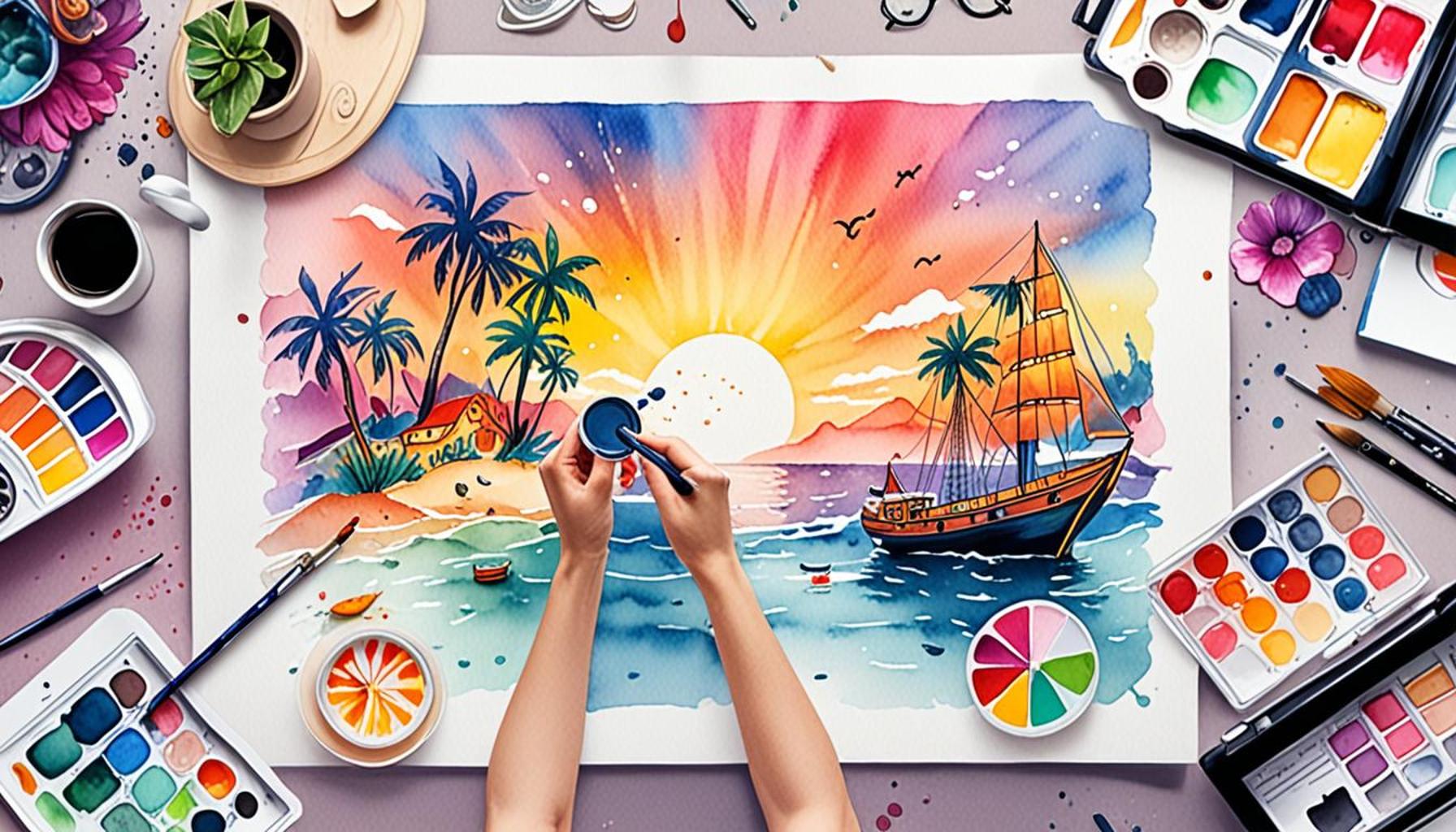The Importance of Visual Narrative in Digital Marketing Campaigns

The Impact of Visual Storytelling in Marketing
In an age where the attention span of consumers is dwindling, grabbing their interest requires innovative strategies. Brands face the daunting task of breaking through the digital noise, and one of the most powerful tools they have in their arsenal is visual narrative. This technique leverages the combination of images, videos, and compelling storytelling to resonate with audiences on a deeper level.
Emotional Connection
At the heart of visual narratives is the ability to forge an emotional connection with the audience. Research shows that consumers are more likely to remember a brand that evokes emotional responses. For instance, consider the “Like a Girl” campaign by Always, which used powerful imagery and heartfelt testimonials to challenge stereotypes and empower young girls. This campaign not only was memorable but also sparked conversations about gender equality, showcasing how visuals can stir emotions that words sometimes cannot.
Enhanced Retention
Studies reveal that people by far retain visual information better than textual content, which is pivotal for brands striving for long-term recognition. Images and videos are processed faster by the brain, which makes them essential in marketing. Take the popular social media platform Instagram as an example; its emphasis on visual content has proven that companies leveraging attractive visuals see higher engagement rates. This highlights the necessity for brands to incorporate striking visuals that matter to their target audiences, ensuring that their messaging leaves a long-lasting impression.
Increased Engagement
In the sphere of social media, increased engagement is a critical metric that indicates audience interest. Brands that share eye-catching visuals often see their content shared more frequently, creating a ripple effect that broadens their reach. For instance, Coca-Cola’s holiday campaigns utilize festive visuals that evoke cheer and nostalgia, leading hundreds of thousands to share these posts across platforms, amplifying the brand’s visibility organically.
Brands like Nike and Apple are superb examples of effectively using visual narratives within their marketing strategies. Nike’s “Just Do It” campaign intertwines powerful visuals of athletes overcoming challenges with stories that motivate and inspire. Apple, on the other hand, showcases the artistry of its products with minimalist design and powerful images that highlight functionality and innovation, making both brands resonate with consumers on multiple levels.
As the landscape of digital marketing continues to evolve, the ability to craft and utilize visual narratives is not just a useful skill; it is essential for any brand looking to thrive. By mastering this art, companies can significantly enhance their reach, engage effectively with consumers, and foster lasting relationships that translate into loyalty and success.
LEARN MORE: This related article may interest you
Visual Narrative: A Cornerstone of Digital Engagement
The digital landscape is saturated with content, making it imperative for brands to differentiate themselves. One crucial aspect of achieving this is through visual narrative, which not only conveys a message but also enlivens it through imagery and video. By weaving together these elements, brands create a cohesive story that captures attention and drives engagement. In essence, visual narratives elevate the traditional marketing message into a resonant experience that consumers are eager to engage with.
Understanding Your Audience
To effectively harness the power of visual storytelling, brands must first understand their target audience deeply. This implies not just knowing demographic data, but also grasping the interests, aspirations, and pain points of potential customers. Here are some vital questions brands can explore:
- What are the values that resonate with my audience?
- What visual styles do they gravitate towards?
- Which platforms do they predominantly use for content consumption?
Data analytics tools play a crucial role in shedding light on these aspects, offering insights into consumer behavior that can guide the creation of relatable and impactful visual narratives. For instance, understanding that younger consumers prefer platforms like TikTok for quick, engaging content can direct brands to develop short, attention-grabbing videos rather than lengthy articles.
Consistency Across Channels
Another significant factor in a successful visual narrative is consistency. A cohesive visual identity enhances brand recognition and fosters trust among consumers. Brands should ensure that their imagery, color palette, and tone remain consistent across all digital channels, whether it’s social media, email marketing, or their official website. This consistency not only solidifies brand identity but also reaffirms the messages being communicated.
Moreover, employing a recognizable visual theme helps consumers connect with the brand on an emotional level. For example, Starbucks utilizes the imagery of coffee beans, warm cups, and inviting café scenes across its platforms, creating a visual narrative that evokes comfort and community. Each image resonates with consumers, encouraging them to associate the brand with positive experiences and emotions.
Telling a Unique Story
In the competitive arena of digital marketing, crafting a unique story is essential. Brands that can distinguish themselves through innovative visual narratives often capture the hearts and minds of their audience. Messaging should go beyond simple promotion to embrace storytelling that reflects the brand’s ethos, mission, and vision.
Consider the approach taken by brands like Dove, whose campaigns often focus on real beauty and acceptance. Through real-life, relatable stories accompanied by impactful visuals, Dove successfully positions itself as a champion of self-esteem and authenticity. This not only garners consumer loyalty but also encourages a community around shared values.
In today’s digital marketing environment, the effective use of visual narrative is not just an advantage; it is a necessity. By understanding the audience, maintaining consistency, and telling unique stories, brands can significantly improve their outreach, engagement, and overall success in a cluttered marketplace.
| Advantages | Impact on Marketing |
|---|---|
| Enhanced Engagement | Visual narratives capture attention more effectively than text alone, leading to higher user interaction and retention rates. |
| Improved Brand Recall | Stories presented visually can be remembered more easily, enhancing brand recognition and loyalty over time. |
As digital marketing evolves, one key element that cannot be overlooked is the power of storytelling through visuals. In an age where attention spans are shorter than ever, creating a compelling visual narrative can significantly enhance the effectiveness of marketing campaigns. By utilizing engaging imagery and narrative techniques, brands can differentiate themselves in crowded marketplaces.Moreover, video marketing is becoming increasingly influential, with studies showing that video content can drive conversions and lead to higher engagement rates. Integrating strong visual storytelling elements not only enhances the emotional connection with consumers but also aids in conveying complex information in a digestible manner.To truly leverage visual narrative, marketers must focus on brand alignment in their visual content. Consistent use of visuals can create cohesiveness, helping to establish brand identity in the minds of consumers. Offering a unique and authentic narrative fosters trust and loyalty, which are crucial for sustaining long-term customer relationships in digital spaces.
CHECK OUT: Click here to explore more
The Impact of Emotions in Visual Storytelling
One of the powerful aspects of visual narrative in digital marketing is its ability to evoke emotions. Emotions play a critical role in decision-making, and research indicates that people are more likely to remember and share content that elicits an emotional response. By effectively utilizing visual elements such as color, composition, and imagery, brands can connect with their audiences on a profound level, leading to increased engagement and loyalty. For example, studies have shown that visuals with warm colors generally evoke feelings of excitement and warmth, while cooler colors can inspire calmness and trust.
Leveraging User-Generated Content
In today’s marketing landscape, user-generated content (UGC) has emerged as a key player in shaping visual narratives. Encouraging customers to share their experiences through images, videos, and testimonials not only enhances authenticity but also creates a sense of community around the brand. Brands like GoPro have harnessed UGC effectively by showcasing stunning photos and videos captured by their customers. This strategy not only highlights the product’s capabilities but also creates an emotional connection with potential buyers who see themselves engaging in similar adventurous experiences. UGC presents a dynamic way to incorporate authentic stories and expand the brand’s visual narrative.
Adapting Visual Content for Various Platforms
Given the variety of digital platforms available, adapting visual content to suit each medium is crucial. Each platform has its own unique attributes, audience expectations, and content formats. For instance, an Instagram marketing campaign thrives on high-quality images and short videos, whereas a platform like YouTube favors longer, more engaging video content. To maximize the effectiveness of visual storytelling, brands need to understand the intricacies of each platform. Research indicates that video content consistently shows higher engagement rates compared to static images, with viewers retaining 95% of a message when obtained through video as opposed to 10% when read in text form.
The Role of Data in Shaping Visual Narrative
As marketers aim to craft compelling visual narratives, leveraging data analytics can drive informed decisions that resonate with their audience. By evaluating metrics such as engagement rates, click-through rates, and conversion statistics, brands can assess the performance of their visual content and make necessary adjustments. For example, A/B testing different visual narratives can provide insights into what types of imagery, colors, or design elements perform best. Furthermore, understanding audience insights, like the time spent on certain visuals, can guide marketers in creating content that aligns with consumer preferences.
Embracing Emerging Technologies
Innovations in technology have further expanded the possibilities for visual storytelling in digital marketing. Virtual reality (VR) and augmented reality (AR) offer immersive experiences that allow customers to engage with products in unique ways. Brands like IKEA have tapped into AR, allowing customers to visualize furniture in their own homes before making a purchase. This not only enhances the customer experience but also provides a compelling visual narrative that can reduce hesitation and increase conversion rates. As new technologies continue to emerge, marketers must stay ahead of the curve to leverage these tools for enriching their visual narratives.
By recognizing the importance of emotional connection, utilizing user-generated content, adapting visuals for various platforms, leveraging data analytics, and embracing emerging technologies, brands can cultivate stronger visual narratives that resonate deeply with consumers in the crowded digital marketplace.
RECOMMENDED: Check out this similar article
Conclusion: The Transformative Power of Visual Narratives in Digital Marketing
In an era where attention spans are decreasing and competition is fierce, the importance of visual narrative in digital marketing campaigns cannot be overstated. Visual storytelling goes beyond mere aesthetics; it is a strategic approach that combines emotion, authenticity, and engagement to connect brands with their audiences meaningfully. As outlined, leveraging components such as emotional resonance, user-generated content, platform-specific adaptations, data-driven strategies, and emerging technologies can significantly enhance a brand’s visual narrative and its impact on consumers.
As consumers increasingly seek authentic relationships with brands, employing visual narratives that reflect real experiences can enhance trust and foster community. Moreover, by accommodating various digital platforms and leveraging data insights, brands can create compelling and tailored content that stands out amidst the noise. The integration of technologies like VR and AR further enriches storytelling possibilities, offering immersive experiences that resonate deeply with consumers.
Looking ahead, marketers must prioritize visual storytelling as a core strategy in their campaigns. Investing in this approach is no longer just a creative choice; it is a necessity for brands aiming to thrive in a rapidly evolving digital ecosystem. As the landscape continues to change, those who can harness the transformative power of visual narratives will not only engage consumers effectively but also create lasting impressions that drive brand loyalty and impact bottom lines.

